Home > Articles > The Archives > Red and Murphy & Co.
Red and Murphy & Co.
Reprinted from Bluegrass Unlimited Magazine
January 1980, Volume 14, Number 7
The family band is a noble, long-standing tradition in bluegrass and traditional country music, extending back even further than the Carter Family, quite possibly as far back as the beginning of the string band itself. Today, the family unit is as strong as ever in bluegrass, as witnessed by the McLain Family, the Marshall Family, the Cochran Family, as well as such perennials as the Stonemans and the Osborne Brothers.
One of the finest of the newer, up-and-coming family bluegrass bands is Red and Murphy & Co., a Northern Florida-based quartet consisting of husband and wife Red and Murphy Henry, plus Murphy’s two sisters, Laurie and Nancy Hicks. To date, the group has issued three albums on their own Arrandem label, “Riding Around on Saturday Night” (AR10), “Fast Picks and Hot Licks” (AR 20), and the newly-released “Pall Mall Reds” (AR 30). A fourth album “My Everyday Silver is Plastic,” is to be released in the near future.
Red and Murphy’s three albums document a steady progression from a trio firmly rooted in the Bill Monroe/Flatt and Scruggs tradition, yet offering their own unique slant to a number of original songs and country hits, to a solid “mainstream” bluegrass quartet featuring strong material and a thoroughly personal approach which is undeniably contemporary (though far from “progressive” in the newgrass sense), yet still squarely based in classic bluegrass. The group’s instrumentation on stage is somewhat sparse, with Murphy on banjo, Red and Nancy (a fairly recent addition, having first appeared on the “Fast Picks” album) on guitars, and newest member, Laurie, on bass. On records, however, overdubbing gives Red ample opportunity to show what he can do on mandolin and fiddle as well. All four members are capable of singing lead, while the group has also explored many of the two-, three-, and four-part harmony combinations their distinctive voices allow.
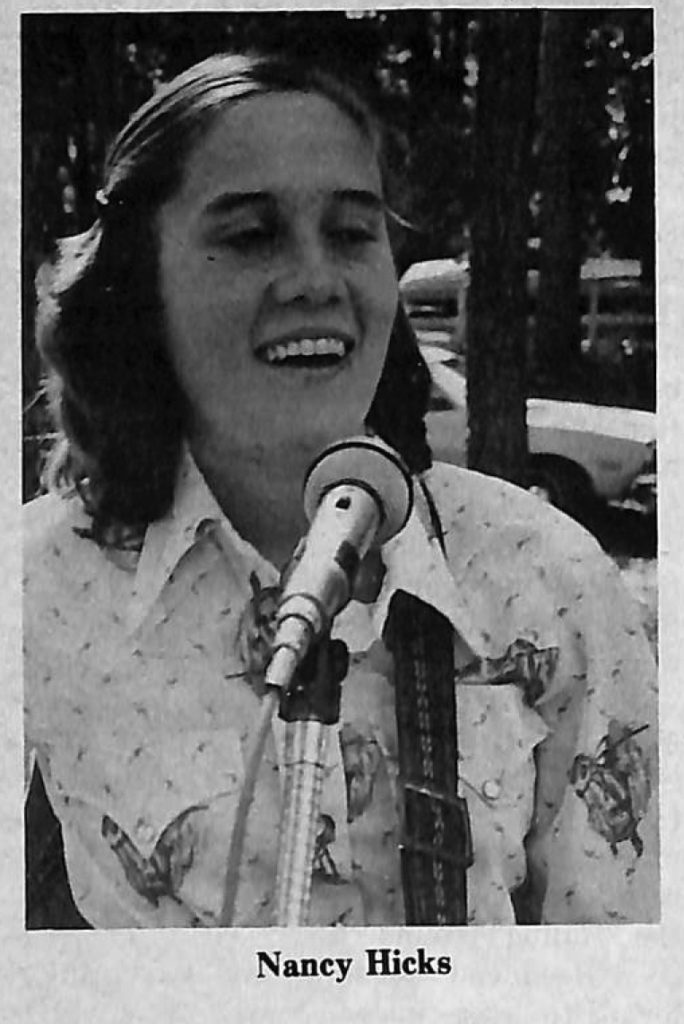
Interestingly, neither Red nor Murphy comes from a bluegrass or country-music background. Red was born Bryan W. Henry, Jr., November 22, 1948, in Gainesville, Florida; he was raised in Jacksonville and Tallahassee. Although he recalls that his early musical training was “pretty sparse as far as anything resembling bluegrass music was concerned,” he credits his youthful exposure to more formal music as an important aid in working out Red and Murphy’s vocal arrangements.
“My early musical background centered around the choir in the Episcopal church in Jacksonville, Florida. The primary musical influence there was the choir director, Roselind McEnulty, an excellent classical musician and first-rate teacher. I sang in her choir for about five years, 1959-64. I also took piano lessons from her for about two years of that time. I was playing in the high school band, too, mostly clarinet and alto clarinet, both of which I disliked and never mastered. So I was able to tie together what I was learning about music theory from several sources simultaneously.
“Even though I never became a skilled musician on the band instruments or piano, and never developed an ideal singing voice, I learned a great deal about control of a vocal ensemble—little technical items concerning what to do with vowels and consonants, and so forth—and developed a fair understanding of chordal structures and relation ships. These things are a big help to me now—we aren’t trying to sound (and shouldn’t try to sound) like we have classically trained voices, but I know whenever we try a number, just where all the harmonies are and the best key for us to try it in to begin with. An understanding of at least the simple chordal structures involved in most bluegrass helped me to learn the mandolin, too, more quickly than if I had never learned anything about the chords.”
Red’s initial exposure to bluegrass came from his uncle (three years older than Red), John Hedgecoth, “although the groups he played with played some diluted stuff back in the mid-60’s. He’s an excellent bluegrass banjo picker now, living up in Nashville, playing with the Shinbone Alley All-Stars, the Misty Mountain Boys, and Buffalo Gals—renamed the Buffalo Pals when he fills in with them—and several other groups.” Red remembers a friend named Joel Davis giving him a copy of “Flatt and Scruggs At Carnegie Hall” in 1965. “I listened to that album a couple of hundred times until I liked it; bought some more Flatt and Scruggs records, even started listening to the Martha White Morning Show over WSM. By 1967, I wanted to learn to play some of that stuff, but the people I knew were way ahead of me on banjo and guitar, and fiddle was out of the question to a beginner. That left the mandolin, so I bought a used Gibson A-50. John showed me half a dozen tunes and I was off to the races, spending a lot of hours playing music. I studied Bill Monroe, Dean Webb, Jethro Burns, Ralph Rinzler, and everybody else whose records I could find, until I realized that I could learn best by studying Monroe. I got a Martin D-18 guitar in 1968, and began to learn some fiddle tunes and Doc Watson material on it. Banjo was next, in 1969. I didn’t have a playable fiddle until 1971, and didn’t learn much on fiddle till about 1974.”
Red’s first band, in 1968-69, consisted of John Hedgecoth and Mike Johnson alternating on banjo and guitar, Red on mandolin, and usually Mike’s mother, Polly Johnson, on bass. After John moved to California, a Kentuckian named Herb Schottland played guitar, while Mike moved to banjo and fiddle.
“Up until Herb joined the group, it had been pretty irregular, and we played under such names as the Palm Valley Boys. With Herb, the name became the Sounds of Bluegrass, and we played together starting in late ‘69. Bluegrass music was just getting cranked up in Florida then, with little festivals at Salt Springs, Green Cove Springs, and the big White Spring Folk Festival every year. In late ‘70, I left to join the Air Force, and Herb left to go back to Kentucky, but Mike and his mother kept the band going, and have done a great job popularizing bluegrass in Florida ever since.”
Around 1971, Red found himself in Del Rio, Texas, where he often listened to the legendary country-music radio station, XERF. “At night, there was preaching and preaching. I mean, there were the shouting preachers, the gasping preachers, the shrieking preachers, and so forth, sending their message across the plains with that 250,000 watt AM signal. They were selling prayer cloths, gospel albums, and a great many other things with a verve and confidence that made me think they were raking in the money. I was amazed.”
In May 1972, the Air Force reassigned Red to Dover, Delaware. “Over the next year and a half, I did a lot of informal picking with people in Delaware, Pennsylvania, and New Jersey—Ty Searfoss, Dick Gurlach, John Stey, and a fellow in the Air Force with me named Jesse Miller, among others. Jesse ended up renting a house trailer from Charlie Bailey, of the Bailey Brothers, and after a while I rented a trailer from Charlie, too. Charlie was definitely the most significant musical influence on me during this entire period. I learned a great deal from him about the importance and beauty of melody of the mandolin, and was struck by the touch he had on the instrument and his singing ability, especially with his brother Dan. If all mandolin pickers had a chance to listen to and pick with someone like Charlie, you’d hear a lot fewer notes in this country and a lot more music.”
Red’s next stop (August ’73) was Charleston, South Carolina, where he joined Low Country. “Band members included George Del Porto, a fine banjo player, Smokey Joe Ellis, a good smooth fiddler with many years of experience, Jesse Miller, who had been transferred with me, on guitar, and a fellow named Bill, whose full name I’ve forgotten, playing guitar.”
Every chance he had, Red was out picking at festivals, fiddle contests, or anywhere else he could find musicians. It was at one such festival in Lavonia, Georgia, 1972, that he met Murphy Hicks. “We kept encountering each other at the shows in that part of the country until we decided to play music together, and got married in October of ’74.” Murphy puts it more colorfully, “I kept running into Red at lots of festivals in 1974, till we decided to get married, and I didn’t run into him anymore, I just took him along.”
Murphy soon replaced Del Porto as Low Country’s banjo picker. Red and Murphy then moved to Florida in May of ’75, Red having left the Air Force four months earlier. As Red says, “It’s nice to be a pilot, but it’s better to play music!” Red and Murphy worked as a two-piece unit for most of that year, with Argen, Murphy’s sister, joining them on bass during the summer. Argen became a full-time member of the group in 1976. She has now been replaced by another of Murphy’s sisters, Laurie.
Murphy Henry was born Nora Murphy Hicks, May 18, 1952, in Spartanburg, South Carolina. Murphy recalls her Granddaddy Hicks as being one of her earliest musical influences, as recounted in “Grandmother’s Song,” on the “Riding Around” LP.
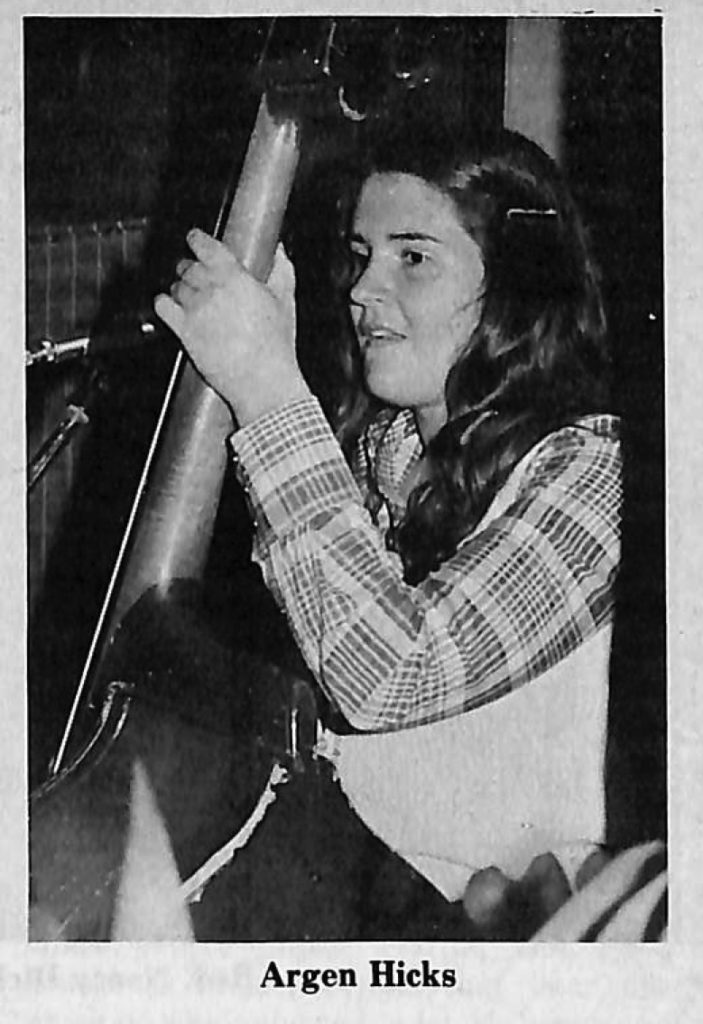
“He loved to sing, and especially loved to sing gospel songs from the hymnbook. I grew up attending the Baptist church in Clarksville, Georgia, where I lived since I was six weeks old. Our church, while not being ‘big city,’ was definitely more up-town than some of the other churches further out in the country. And while I loved singing in our church, I loved even better once a year going out to Granddaddy’s old church in the next county, where we held the annual Hicks reunion every August. They sang out of the old paperback hymnals, some of them Stamps-Baxter, and I loved those songs more than any and I loved to hear those people sing them. My sisters and I would always sit in the choir and we would always be called on to do a special number, one we had worked up for the occasion at Grandaddy’s request. This was my first experience at performing in public (not counting piano recitals). I would play the piano and sing, and my four sisters would line up by the piano in stairsteps and sing too.”
Murphy took piano lessons for six years, beginning in the fourth grade. By her own admission, she “never got really good; I could and did play for Sunday School, but that was about it.” In fourth grade, she also had her first stringed instrument, a plastic ukulele, later to moving to baritone uke, eventually graduating to guitar. She also took violin lessons from tenth to twelfth grades, “but never practiced much and never got very good at all.”
She did not become aware of bluegrass until her college days, though she does remember Granddaddy Hicks listening to the Opry and 78’s by Bill Monroe and Roy Acuff. She also watched Saturday afternoon country-music television programs, “but I just did that when I happened to think of it.”
Murphy began her career as a single act, “just me and my 12-string Yamaha guitar. I played in little coffeehouses, etc., around the University of Georgia in Athens, and did folky material mixed with country and gospel songs. I enjoyed this and might have continued in this vein but for my intro to bluegrass.”
That introduction came courtesy of well-known Florida singer/guitarist/song- writer/raconteur Gamble Rogers, who greatly influenced Murphy’s; solo repertoire.
“I went to see him every night I could every time he came to town, and learned many of the songs he did. One night he said there was a bluegrass festival going on up the road an hour or so at Lavonia, Georgia, and he was going up Sunday and that everybody should go. So a friend and I did, and it was great—Monroe, Flatt, Crowe, etc. I was much taken with it all, and made advance reservations to attend another one several months later in Atlanta.”
Not long after this initiation into bluegrass, Murphy joined Betty Fisher’s Dixie Bluegrass Band as the result of answering a newspaper ad. “There was already a guitar player and a banjo player, so I tried my hand at the bass. This was 1973; I played with this band for one and a half to two years. I met a lot of people and learned a lot things. I also started trying to play the banjo about this time, as I soon discovered that people don’t pay much attention to the bass player, and it was hard to hear what the bass player was doing. Also, for jam sessions I wanted to participate more by playing a lead instrument and banjo was the loudest.”
Since forming their own group, Red and Murphy have evolved a style which they prefer to think of not so much as “bluegrass” (though that is how 99 out of 100 listeners would not doubt categorize it), but as “Red and Murphy music.” Red explains, “It takes a very strong experienced, thoroughly competent band to play good bluegrass music, and although we sing some of the old songs occasionally, we don’t really have the band proficiency to play them as well as I’d like to. Our influence has come both from individuals in our background and from recordings, although lately the recordings have taken over. The Mercury Flatt and Scruggs material—that’s bluegrass music. That is nearly all we study. We use what we learn there to play and present our own music—what we write and perform—more effectively.”
Murphy is more specific on how “Red and Murphy music” evolved, and how the group’s limitations affected it. “I don’t think we’ve made a conscious effort to develop a ‘style,’ it just developed. I don’t mean to imply that our music developed accidentally. When we started out, we were a 3-piece group. With one male lead and two females, you automatically get a different sound. To complicate matters, Red has a very low voice, so it was hard for me to sing harmony that low. Argen’s voice was in about the same range as mine but so strong, so I needed to do the leads. But then it was hard for her to tenor me. Plus the fact that sometimes Red could not even get the baritone to my leads because they were too high. So that’s a lot of things to deal with. That in itself limited our selection of songs.
“The other limitation that not too many people think about is that girls normally sing bluegrass songs in ‘non-standard’ keys. My voice is on the low side, but even so I need to sing so many of the standards in the key of C. This poses a problem instrumentally. For starters, the banjo must capo up five frets. The guitar must capo up five frets, or play in open C, which is simply not as punchy—it’s hard to get a bluegrass sound out of a bar F chord. The instruments lose a lot of sound when you capo up that high. It’s okay once in a while, but if you do most of a set there, there definitely seems to be something lacking. You encounter worse problems if you have to deal with a fiddle or mandolin—how do you get the ‘proper’ sound for ‘Uncle Pen’ played in the key of C?
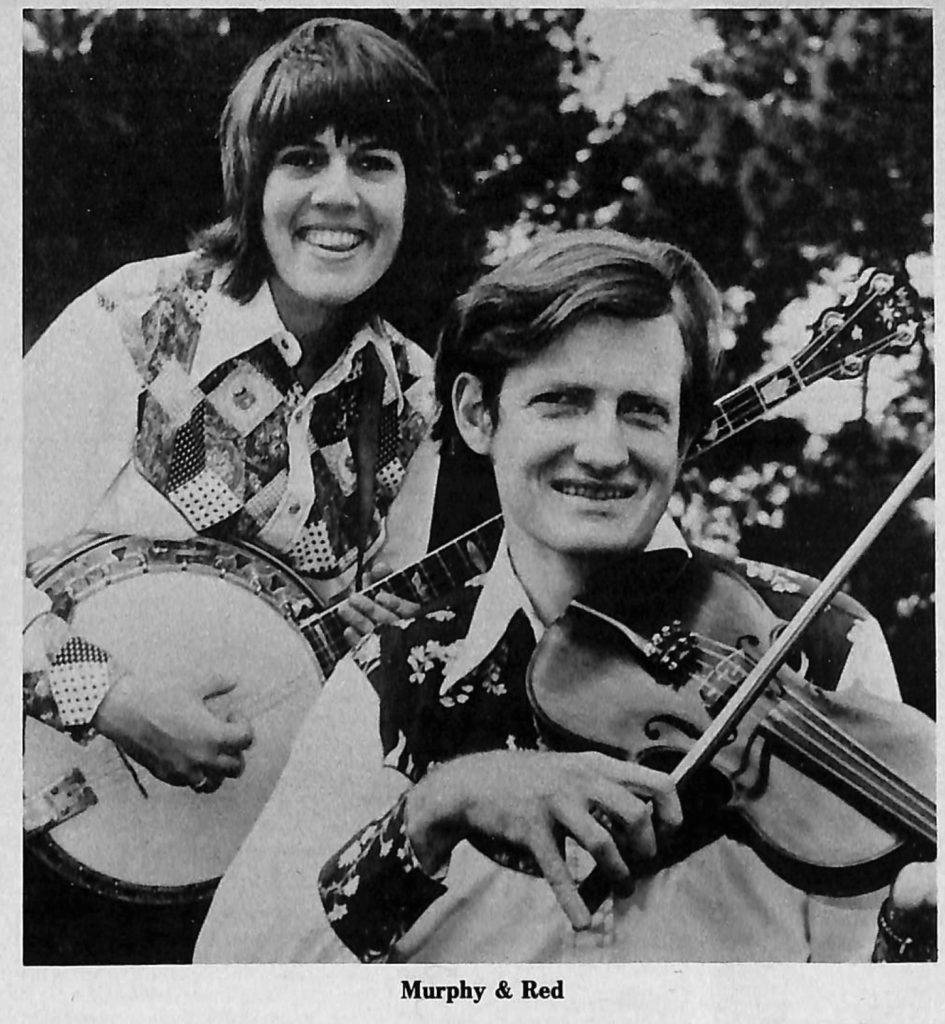
“So, what it boiled down to for us was that Red sang the bluegrass numbers and we stacked the harmony up. We did not like that sound the best, it was just what had to be done with the voices that we had. I ended up singing our country material, such as ‘Hey Good Looking’ and ‘California Cottonfields’ (both on “Riding Around”). That did not satisfy me. When we started playing we were not performing much original material. I had not written much and what I had written was a little too ‘family’ to sing in the bars we played a lot. We frankly did not like to do extremely personal material—for example, ‘Grandmother’s Song’—for callous audiences. So I started writing songs that I could sing about subjects with universal appeal, purposely keeping them on the light side. Our non-original material we choose for many of the above reasons. We have to like the song first and we have to be able to sing it and properly play it second. We generally follow the recorded arrangement with allowances for our band’s makeup.”
Both Red and Murphy feel their three albums accurately chart the group’s musical progress. According to Murphy, “I sincerely don’t think that, given the circumstances, we could, would, or should have done anything differently. “Riding Around” does not sound quite as good to us now as it did then—or maybe I should say ‘to me,’ for Red has always been very objective about our music and, he would admit that it was the best we could have done at the time. As I grow musically, I recognize deficiencies in our earlier albums, but I am very proud of them for that is where we were then.” Red adds that in their opinion, their most recent album, “Pall Mall Reds,” is by far their best one yet.
When asked about the state of bluegrass in the North Florida/South Georgia region, Red’s answer was an encouraging “healthy.” He names Chubby Anthony and Big Timber as “the best band I’ve heard in Florida, Georgia, Alabama, or the Carolinas.” He characterizes Anthony, long-time fiddler for the Stanley Brothers, as “an excellent bluegrass singer and songwriter who has an amazing driving proficiency on several instruments.”
Red and Murphy & Co. is, like Big Timber, a full-time band, though Murphy also teaches banjo in Gainesville. There is ample opportunity in the area for a bluegrass band of their caliber to play before appreciative audiences. According to Red, “There are two or three respectable festivals per month within four or five hours drive. The club situation is not as good as it used to be, but I’d rather play the festivals anyway. In Florida, there is a very diverse audience for bluegrass. The crowds at the festivals in Virginia, Maryland, and Pennsylvania seem to be mostly younger folks, the crowds in the Carolinas seem older. But around here there’s a good mix-and that’s good for us, because I think we appeal to a wide range of ages. The working environment, though, is the most important part. There seems to be little of the rivalry or feuding between bands and individuals that you find in many other parts of the country.
Although the dominant personalities in Red and Murphy & Co. are, of course, Red and Murphy themselves, a few words are in order about Murphy’s sisters Laurie Hicks and Nancy Hicks. Both had similar musical upbringings to both Red and Murphy, singing in the church choir and playing in the school band, but neither played music seriously before joining forces with their sister and brother-in- law. Indeed, it was Murphy who taught them the rudiments of bluegrass guitar and mandolin. According to Red, “Nancy’s ability both in singing and in composing has been developing rapidly since she joined us, and provides us now with some very valuable help in both areas. On the new album, her song ‘Two Of A Kind’ shows very well how she can sing.”
As Laurie and Nancy continue to expand and mature musically, their contributions to “Red and Murphy music” should become increasingly significant. If they continue to grow at their present rate, it shouldn’t be long at all before they begin to be invited to some of the major festivals outside the Florida/Georgia/Alabama region, their records began to attract considerably more attention outside their home territory, and their original material begins to pop up in the repertoires of other bluegrass bands. Keep a close watch on Red and Murphy & Co.—another name is about to be added to the long list of family bands who’ve enriched bluegrass and country music through the decades.
Share this article
1 Comment
Leave a Comment Cancel Reply
This site uses Akismet to reduce spam. Learn how your comment data is processed.
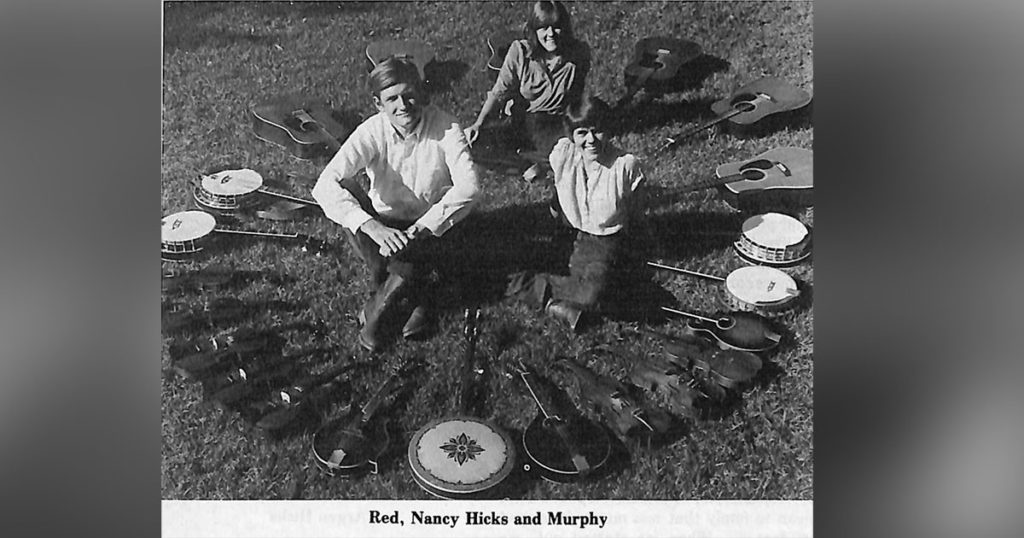
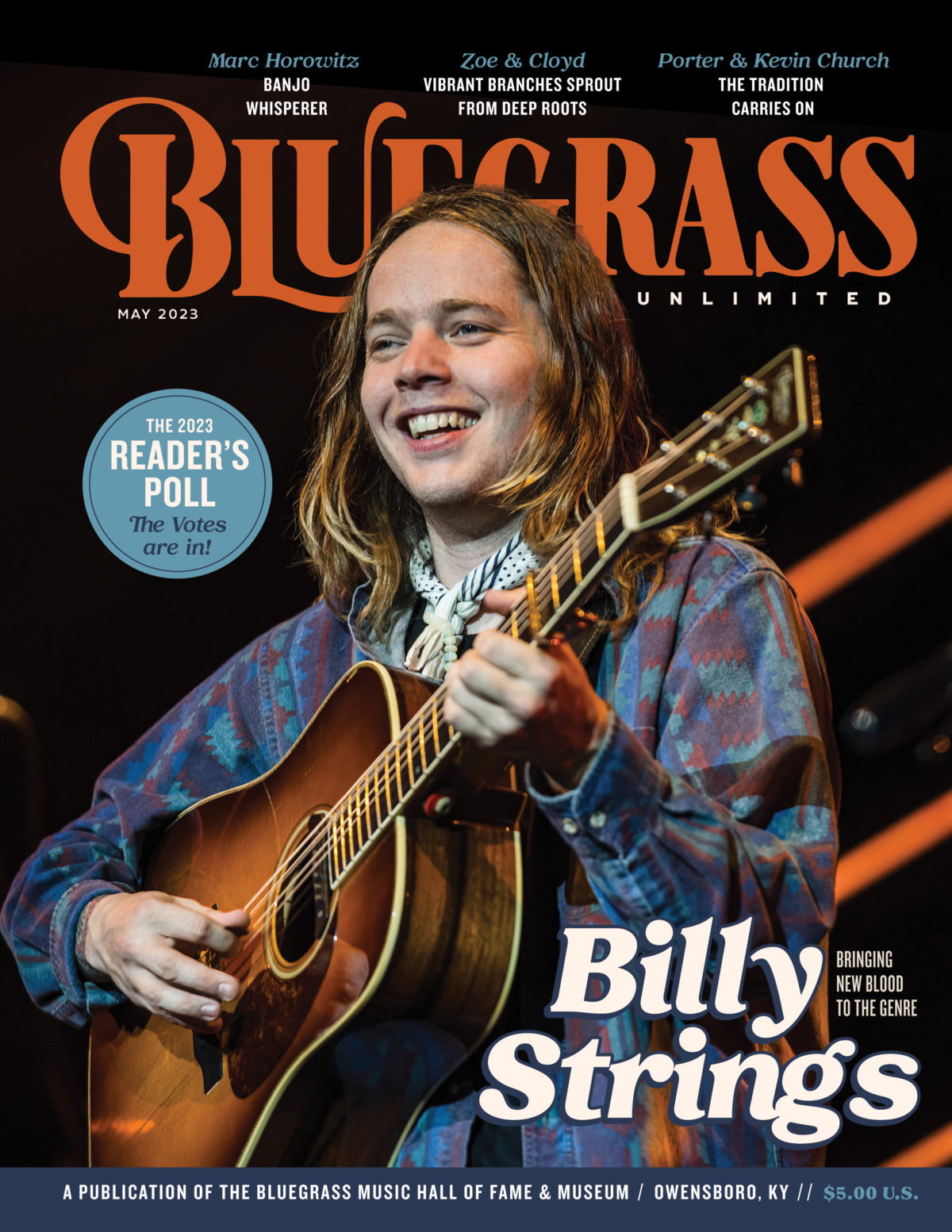
Great folks!! And what amazing children they have. I have learned a lot from Murphy banjo instruction dvds! They are all awesome musicians.